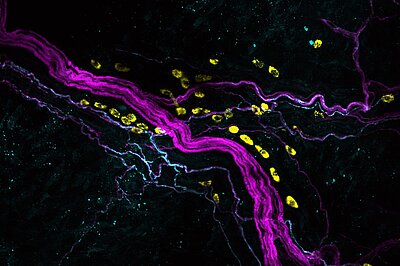Mechanisms of postoperative pain revealed
In their research, the team led by Philipp Starkl, Shane Cronin and Josef Penninger built on earlier findings on the role of the substance tetrahydrobiopterin (BH4) in neuropathic pain: the higher the concentration of BH4, the more severe the pain. "Whether this correlation also applies to postoperative pain has not yet been investigated," says Josef Penninger (Clinical Department of Laboratory Medicine at MedUni Vienna, IMBA, University of British Columbia, Vancouver, Helmholtz Centre for Infection Research, Braunschweig), describing the initial situation of the study.
In a series of experiments on mouse models with surgically induced skin injuries and with the help of novel analytical methods, the researchers revealed both the central role of BH4 in postoperative pain and the underlying mechanisms. As it turned out, the innate immune system plays a decisive role here. The signalling cascade initiated by tissue injury starts in special immune cells (mast cells) that are positioned near pain-sensing nerves in the skin and act as a BH4 production site after an operation. "In mice whose mast cells did not produce BH4, we observed a drastically reduced sensitivity to pain after surgery. Conversely, we found that increased BH4 production by mast cells was associated with increased pain," reports Shane Cronin (Clinical Department of Laboratory Medicine at MedUni Vienna, IMBA).
With the key role of mast cells in pain perception, the research team has also found a possible solution to the puzzle of the function of these cells in the body: "Until now, we mainly knew their influence in allergic reactions and wondered why we have retained this cell type over hundreds of millions of years of evolution despite its harmful and dangerous role in allergies," says Philipp Starkl (Department of Medicine I at MedUni Vienna), emphasizing the significance of the findings.
Pain is important to warn the body of danger and to ensure efficient healing after injuries. In many cases, however, post-operative pain becomes chronic and persists for several months after the operation, even though the body has already healed. Current treatment methods are sometimes associated with considerable side effects and often only have limited effectiveness. In the search for alternatives, research into the molecular and cellular mechanisms involved in post-operative pain perception has long been the focus of medical science. A promising approach has now been found by blocking BH4 production in mast cells. The team led by Starkl, Penninger and Cronin has already developed a therapeutic approach in which an active substance can be applied directly to the skin in order to specifically and prophylactically reduce the BH4 concentration. "We see great potential here for a local and targeted therapy option to reduce both post-operative pain and the likelihood of the pain becoming chronic," emphasise the study authors in advance of further investigations that are intended to deepen and confirm the results.
